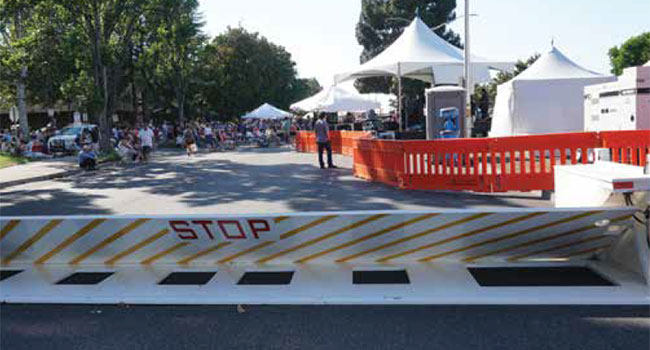
Industry Professional
Festive Security
How a California city protects attendees from potential vehicle attacks
Reacting to tragedies in
London and Berlin,
among others, where vehicles
were used as weapons
against large numbers
of pedestrians, the Fremont (Calif.) City
Council decided to heighten protection for
its citizens from errant drivers and terrorist
vehicles driven at events such as their
Fremont Festival of the Arts, Niles Antique
Faire and Flea Market, Festival of
India, parades and other affairs. Many of
these events attract large numbers of people
and, of course, gathers them into confined
locations. For instance, the 300,000
person Fremont Festival of the Arts, one
of the largest street festivals west of the
Mississippi River and toted as California’s
premiere art, wine and music festival, is no
small undertaking. The threat of an attack
is a real possibility.
Blocking an Attack
In August of this year, the festival had more
than 500 booths filled with unique, one-ofa-
kind pieces, not easily found elsewhere.
From paintings and drawings, to jewelry
and clothing, to household decorations and
furnishings, every single piece of art sold is
handmade. More than 3,000 volunteers are
needed to run the festival. If you lined up all
the booths into a straight line, it would run
four miles. No wonder, then, after the tragedies
at Nice and elsewhere, the city felt it
was important to protect people from vehicle
attack, stopping a vehicle from plowing into
a crowded area of innocents.
In an article in the East Bay Times, Fremont
Police Chief Richard Lucero emphasized
that special events are an important
part of a community’s fabric.
“They provide an opportunity for people
to come together in different ways than they
do in their ordinary, day-to-day life and have
a chance to connect,” Lucero said. “In order
for it to be effective, it’s got to be safe.” He
continued by saying that the potential danger
of cars driving into public gathering areas
to kill and hurt people is “very real.”
“When somebody comes to our festival,
we don’t want them to worry about their
safety,” said Lt. Matt Snelson of the Fremont
Police Department.
By their very nature, terrorist attacks are
unpredictable and predicated on surprise.
Staying one step ahead by identifying vulnerable
areas, and securing them, is critical
to staving off vehicular attacks. That means
being able to deploy security equipment in
tough conditions, at a moment’s notice.
Ed Fonseca, president of Fun & Game
Rentals, who is in charge of many of the festival
rides, related that, in the past, festival
operatives had to park their own cars in the
entrances to help guard festival attendees.
Operators would need to run and move their
cars anytime an authorized vehicle had to
enter festival grounds.
To better protect visitors to local events,
the city decided to purchase 12 Delta portable,
temporary barricades that would
control access to the festivities. Fonseca explained
that, with the portable barricades,
the entrances are closed to traffic but can
be lowered to let emergency, authorized law
enforcement and delivery vehicles through.
Thus, operators will no longer need to keep
scurrying to their vehicles whenever someone
needs to enter.
Contrary to water or cement barricades,
the mobile deployable vehicle crash barriers
carry a K8 rating (M40 ASTM rating), stopping
7.5 ton vehicles traveling 40 mph, and
tow into position to control vehicle access
within 15 minutes. No excavation or subsurface
preparation is required. Once positioned,
the totally self-contained MP5000’s
unpack themselves by using hydraulics to
raise and lower the barriers off their wheels.
No hand cranking is required. DC-powered
pumps then raise the barrier to keep vehicles
out or lower the barrier to let vehicles
through. Wheels are stored along the sides
and the vehicle ramps fold out, completing
the implementation. To move the barrier
from that spot to another, the procedures are
simply reversed.
This year’s August festival was the first
test of the new security system. The 12 totally
self-contained MP5000’s were towed to the
12 entrances into the festival and successfully
controlled vehicle access for the duration.
Realizing that protecting people from
vehicle attack is no small responsibility—it
is becoming mandatory—made news in the
Bay Area. The city was lauded for its investment
in having the right equipment in place
to secure its events from vehicle threat and
prevent what is becoming all too common
human tragedy, bringing peace of mind to
event attendees. Besides local newspaper
coverage, the local Bay Area CBS television
station, KCBW, even ran a two and a half
minute feature on the new safety protection
with comments from local people.
This article originally appeared in the December 2017 issue of Security Today.